Optimal Planning of Battery Swapping Stations Incorporating Dynamic Network Reconfiguration Considering Technical Aspects of the Power Grid
Abstract
1. Introduction
1.1. Research Motivation
1.2. Research Literature Review
1.3. Shortcomings of Previous Research
- Limited scope: Some studies may have a narrow focus, addressing specific aspects of optimal planning such as sizing, siting, or allocation, without considering the broader context of dynamic power distribution network reconfiguration or comprehensive technical aspects of the power grid like recent modern research that was performed in [4,5,10,21].
- Limited consideration of interactions: The interactions between battery swapping stations and other grid components, such as renewable energy sources, conventional generation, and grid infrastructure, may not be adequately addressed in some studies, leading to suboptimal planning decisions [1,4,19].
- Limited consideration of stakeholder perspectives: The perspectives and preferences of stakeholders such as utilities, EV owners, policy makers, and local communities may not be adequately incorporated into the planning process, potentially leading to suboptimal solutions [24].
1.4. Research Contribution
- Technical and economic integration: This paper effectively combines technical aspects of the power grid, such as voltage stability, system losses, grid reliability, sustainability, and integration challenges, with economic goals in the planning process of battery swapping stations. This study aims to ensure efficient and reliable operation within the broader power grid infrastructure.
- Dynamic network reconfiguration: The importance of dynamically reconfiguring power distribution networks to optimize battery swapping station planning is highlighted. By adjusting network configurations based on real-time demand and supply conditions, the study aims to improve grid flexibility, reliability, and efficiency while accommodating EV integration.
- Multiobjective optimization: This paper explores techniques for optimizing battery swapping station planning considering multiple objectives such as station capacity, grid constraints, renewable energy integration, and operational scheduling. By adopting a multiobjective approach, this study aims to find optimal solutions that maximize overall system performance.
- Risk assessment and resilience analysis: Risk assessments and resilience analyses are conducted to identify vulnerabilities, mitigate risks, and improve the ability of battery swapping stations to withstand disruptions. Addressing these aspects contributes to long-term reliability and operational continuity in the face of uncertainties.
- Environmental impact assessment: Environmental impact assessments are carried out to evaluate the sustainability of battery swapping stations and their potential for reducing carbon emissions in transportation. By assessing the environmental footprint, this study aims to support environmentally friendly infrastructure development and sustainable transportation practices.
1.5. Structure of the Research
2. Problem Statement and Solution Procedure
3. Mathematical Modeling Formulation
3.1. Modeling of Battery Swapping Station
- represents the initial charging power of the electric vehicle.
- denotes the charging battery time constant of the electric vehicle.
- signifies the total time needed to charge the electric vehicle’s battery from zero charge to maximum charge.
- stands for the maximum charging power of the electric vehicle.


- represents the probability coefficient of power consumption in an electric vehicle charging station.
- denotes the success rate of a vehicle in accessing the charging converter.
- signifies the success rate of a vehicle in completing its battery charging.
- = /.c stands for the number of charging stations for electric vehicles.
- C represents the number of BSSs for electric vehicles.
3.2. Modeling of PV and Wind Turbine Power
3.3. Cost Formulation of Renewable and Traditional Generation Units
- represents the penalty factor associated with emissions.
- signifies the penalty factor related to emissions.
- indicates the penalty factor linked to emissions.
3.4. Mathematical Formulation of Technical Objectives
3.4.1. Power Losses and Loss Sensitivity Index
3.4.2. Voltage Deviation Index
3.4.3. Short-Circuit Level Index
3.4.4. Voltage Sensitivity Index
3.4.5. Expected Energy Not Served (EENS) Index
3.5. Modeling of Switching in Dynamic Reconfiguration
3.6. Formulation of the Objective Function
4. Enhanced Multiobjective Optimization Method Based on GWO
5. Result Analysis and Discussion
5.1. Input Data Analysis
5.2. Analytical Insights and Discussion (Unveiling the Findings)
6. Conclusions
Author Contributions
Funding
Institutional Review Board Statement
Informed Consent Statement
Data Availability Statement
Acknowledgments
Conflicts of Interest
Abbreviations
| DG | Distributed generation |
| BSS | Battery swapping station |
| DER | Distributed energy resources |
| EV | Electric vehicle |
| EBs | Electric buses |
| VSC | Voltage source converter |
| GWO | Gray wolf optimization |
| PSO | Particle swarm optimization |
| EMS | Energy management systems |
| RDS | Radial distribution system |
| EENS | Expected energy not served |
| RE | Renewable energy |
| TR | Traditional energy |
| VSI | Voltage sensitivity index |
| PLSF | Power loss sensitivity factor |
| ESS | Energy storage systems |
| MT | Microturbine |
List of Nomenclature
| The initial charging power of the electric vehicle. | |
| The maximum charging power of the electric vehicle. | |
| The charging battery time constant of the electric vehicle. | |
| Signifies the total time needed to charge the electric vehicle’s battery from zero charge to maximum charge. | |
| The probability coefficient of power consumption in an electric vehicle charging station. | |
| The success rate of a vehicle in accessing the charging converter. | |
| The success rate of a vehicle in completing its battery charging. | |
| Stands for the number of charging stations for electric vehicles. | |
| C | The number of BSSs for electric vehicles. |
| PV system output power at the maximum power point. | |
| Wind turbine output power. | |
| Nominal PV power at the maximum power point and standard conditions. | |
| Radiation amount in standard conditions. | |
| Temperature coefficient. | |
| The temperature of the solar cells. | |
| The number of series modules. | |
| The number of parallel modules. | |
| Lower cutoff speed. | |
| Nominal speed of the wind turbine. | |
| Upper cutoff speed. | |
| Nominal power of the wind turbine. | |
| The cost of operating in each time interval t. | |
| The cost associated with the pollution of the units in each time interval t. | |
| Penalty factor for CO2 production. | |
| Penalty factor for SO2 production. | |
| Penalty factor for NOx production. | |
| The powers of the BSS. | |
| The powers of DG. | |
| The powers of the grid. | |
| Charging powers of BSS. | |
| Discharging powers of BSS. | |
| State of charge. | |
| Charging energy. | |
| Discharging energy. | |
| Denotes the number of equality constraints. | |
| Charging/discharging efficiency. | |
| Converter efficiency. | |
| The storage replacement cost. | |
| The roundtrip efficiency of the storage. | |
| The constant cost of the battery swapping station (BSS). | |
| Normal operating cell temperature of the PV system. | |
| The output power of these renewable units. | |
| The variable cost associated with renewable generation units. | |
| The constant costs related to the renewable units. | |
| & | The Voltage of each bus in the network before and after any changes in the network. |
| Resistance of the line. | |
| Reactance of the line. | |
| The aggregate active power of all nodes. | |
| The aggregate reactive power of all nodes. | |
| Dynamic switch. | |
| The weight coefficient associated with the objective functions. |
References
- Kocer, M.C.; Onen, A.; Jung, J.; Gultekin, H.; Albayrak, S. Optimal location and sizing of electric bus battery swapping station in microgrid systems by considering revenue maximization. IEEE Access 2023, 11, 41084–41095. [Google Scholar] [CrossRef]
- Zeng, B.; Luo, Y.; Liu, Y. Quantifying the contribution of EV battery swapping stations to the economic and reliability performance of future distribution system. Int. J. Electr. Power Energy Syst. 2022, 136, 107675. [Google Scholar] [CrossRef]
- Guo, Y.; Lei, X.; Wang, Q. Capacity coordination planning of isolated microgrid and battery swapping station based on the quantum behavior particle swarm optimization algorithm. Int. Trans. Electr. Energy Syst. 2021, 31, e12804. [Google Scholar] [CrossRef]
- Zhang, N.; Zhang, Y.; Ran, L.; Liu, P.; Guo, Y. Robust location and sizing of electric vehicle battery swapping stations considering users’ choice behaviors. J. Energy Storage 2022, 55, 05561. [Google Scholar] [CrossRef]
- Boonraksa, T.; Boonraksa, P.; Pinthurat, W.; Marungsri, B. Optimal Battery Charging Schedule for a Battery Swapping Station of an Electric Bus with a PV Integration Considering Energy Costs and Peak-to-Average Ratio. IEEE Access 2021, 11, 36280–36295. [Google Scholar] [CrossRef]
- Nematollahi, A.F.; Shahinzadeh, H.; Nafisi, H.; Vahidi, B.; Amirat, Y.; Benbouzid, M. Sizing and sitting of DERs in active distribution networks incorporating load prevailing uncertainties using probabilistic approaches. Appl. Sci. 2008, 10, 142–149. [Google Scholar] [CrossRef]
- Sui, Q.; Li, F.; Wu, C.; Feng, Z.; Lin, X.; Wei, F.; Li, Z. Optimal scheduling of battery charging–swapping systems for distribution network resilience enhancement. Energy Rep. 2022, 8, 6161–6170. [Google Scholar] [CrossRef]
- Zhang, M.; Li, W.; Yu, S.S.; Wen, K.; Zhou, C.; Shi, P. A unified configurational optimization framework for battery swapping and charging stations considering electric vehicle uncertainty. Energy 2021, 218, 119536. [Google Scholar] [CrossRef]
- Wang, Z.; Hou, S.; Guo, W. Inventory management of battery swapping and charging stations considering uncertainty. Int. J. Electr. Power Energy Syst. 2024, 155, 109528. [Google Scholar] [CrossRef]
- Fokui, W.S.T.; Saulo, M.J.; Ngoo, L. Optimal placement of electric vehicle charging stations in a distribution network with randomly distributed rooftop photovoltaic systems. IEEE Access 2021, 9, 132397–132411. [Google Scholar] [CrossRef]
- Yuan, Z.; Wang, W.; Wang, H.; Yildizbasi, A. A new methodology for optimal location and sizing of battery energy storage system in distribution networks for loss reduction. J. Energy Storage 2020, 29, 101368. [Google Scholar] [CrossRef]
- Jordehi, A.R.; Javadi, M.S.; Catalão, J.P. Optimal placement of battery swap stations in microgrids with micro pumped hydro storage systems, photovoltaic, wind and geothermal distributed generators. Int. J. Electr. Power Energy Syst. 2021, 125, 106483. [Google Scholar] [CrossRef]
- Wang, H.; Ma, H.; Liu, C.; Wang, W. Optimal scheduling of electric vehicles charging in battery swapping station considering wind-photovoltaic accommodation. Electr. Power Syst. Res. 2021, 199, 107451. [Google Scholar] [CrossRef]
- Koirala, K.; Tamang, M. Planning and establishment of battery swapping station-A support for faster electric vehicle adoption. J. Energy Storage 2022, 51, 104351. [Google Scholar] [CrossRef]
- Boonraksa, T.; Boonraksa, P.; Marungsri, B.; Sarapan, W. Optimal PV Sizing of the PV-Based Battery Swapping Stations on the Radial Distribution System using Whale Optimization Algorithm. In Proceedings of the 2022 International Conference on Power, Energy and Innovations (ICPEI), Pattaya Chonburi, Thailand, 19–21 October 2022; pp. 1–4. [Google Scholar]
- Shaker, M.H.; Farzin, H.; Mashhour, E. Joint planning of electric vehicle battery swapping stations and distribution grid with centralized charging. J. Energy Storage 2023, 58, 106455. [Google Scholar] [CrossRef]
- Garcia-Guarin, J.; Infante, W.; Ma, J.; Alvarez, D.; Rivera, S. Optimal scheduling of smart microgrids considering electric vehicle battery swapping stations. Int. J. Electr. Comput. Eng. 2020, 10, 5093. [Google Scholar]
- Ko, H.; Pack, S.; Leung, V.C. An optimal battery charging algorithm in electric vehicle-assisted battery swapping environments. IEEE Trans. Intell. Transp. Syst. 2020, 23, 3985–3994. [Google Scholar] [CrossRef]
- Balu, K.; Mukherjee, V. Optimal allocation of electric vehicle charging stations and renewable distributed generation with battery energy storage in radial distribution system considering time sequence characteristics of generation and load demand. J. Energy Storage 2023, 59, 106533. [Google Scholar] [CrossRef]
- Qiao, X.; Luo, Y.; Xiao, J.; Li, Y.; Jiang, L.; Shao, X.; Xu, J.; Tan, Y.; Cao, Y. Optimal scheduling of distribution network incorporating topology reconfiguration, battery energy system and load response. CSEE J. Power Energy Syst. 2020, 8, 743–756. [Google Scholar]
- Sultana, U.; Khairuddin, A.B.; Sultana, B.; Rasheed, N.; Qazi, S.H.; Malik, N.R. Placement and sizing of multiple distributed generation and battery swapping stations using grasshopper optimizer algorithm. Energy 2018, 165, 408–421. [Google Scholar] [CrossRef]
- He, C.; Zhu, J.; Li, S.; Chen, Z.; Wu, W. Sizing and locating planning of EV centralized-battery-charging-station considering battery logistics system. IEEE Trans. Ind. Appl. 2022, 58, 5184–5197. [Google Scholar] [CrossRef]
- Erdinç, O. Considering the combinatorial effects of on-site distributed generation and battery-to-X option availability in electric vehicle battery swap station operation. Sustain. Energy Grids Netw. 2021, 26, 100472. [Google Scholar] [CrossRef]
- Jimenez, A.; Garcia, N. Power flow modeling and analysis of voltage source converter-based plug-in electric vehicles. In Proceedings of the IEEE Power and Energy Society General Meeting, Detroit, MI, USA, 24–28 July 2011; pp. 1–6. [Google Scholar]
- Yudai, H.; Osamu, K. A safety stock problem in battery switch stations for electric vehicles. In Proceedings of the Eighth International Symposium on Operations Research and Its Applications (ISORA), Zhangjiajie, China, 20–22 September 2009; pp. 332–339. [Google Scholar]
- Al-Zaidi, W.K.M.; Inan, A. Optimal Placement of Battery Swapping Stations for Power Quality Improvement: A Novel Multi Techno-Economic Objective Function Approach. Energies 2023, 17, 110. [Google Scholar] [CrossRef]
- Qawaqzeh, M.; Al_Issa, H.A.; Buinyi, R.; Bezruchko, V.; Dikhtyaruk, I.; Miroshnyk, O.; Nitsenko, V. The assess reduction of the expected energy not-supplied to consumers in medium voltage distribution systems after installing a sectionalizer in optimal place. Sustain. Energy Grids Netw. 2023, 34, 101035. [Google Scholar] [CrossRef]
- Dereli, S. A new modified grey wolf optimization algorithm proposal for a fundamental engineering problem in robotics. Neural Comput. Appl. 2021, 33, 14119–14131. [Google Scholar]

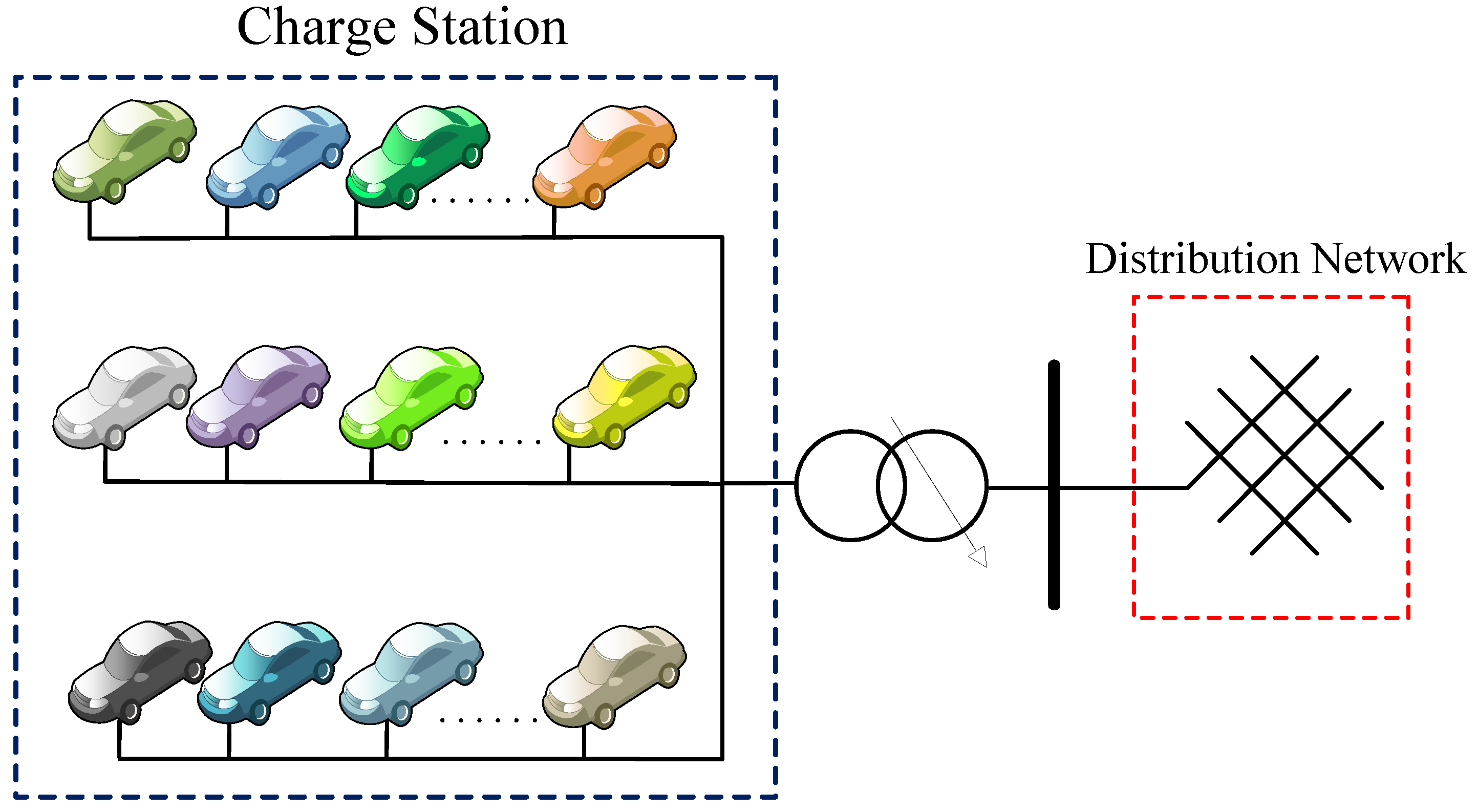


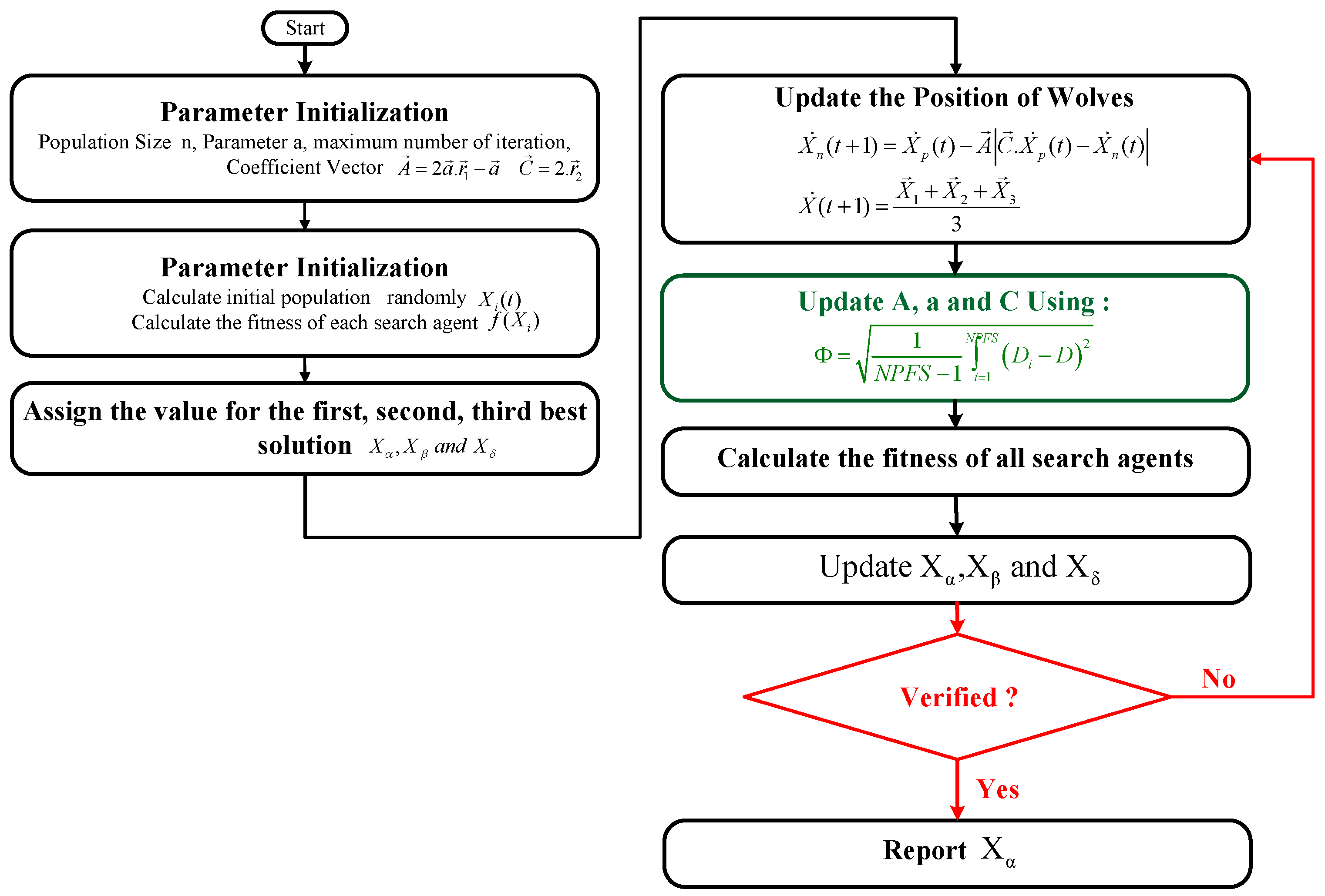
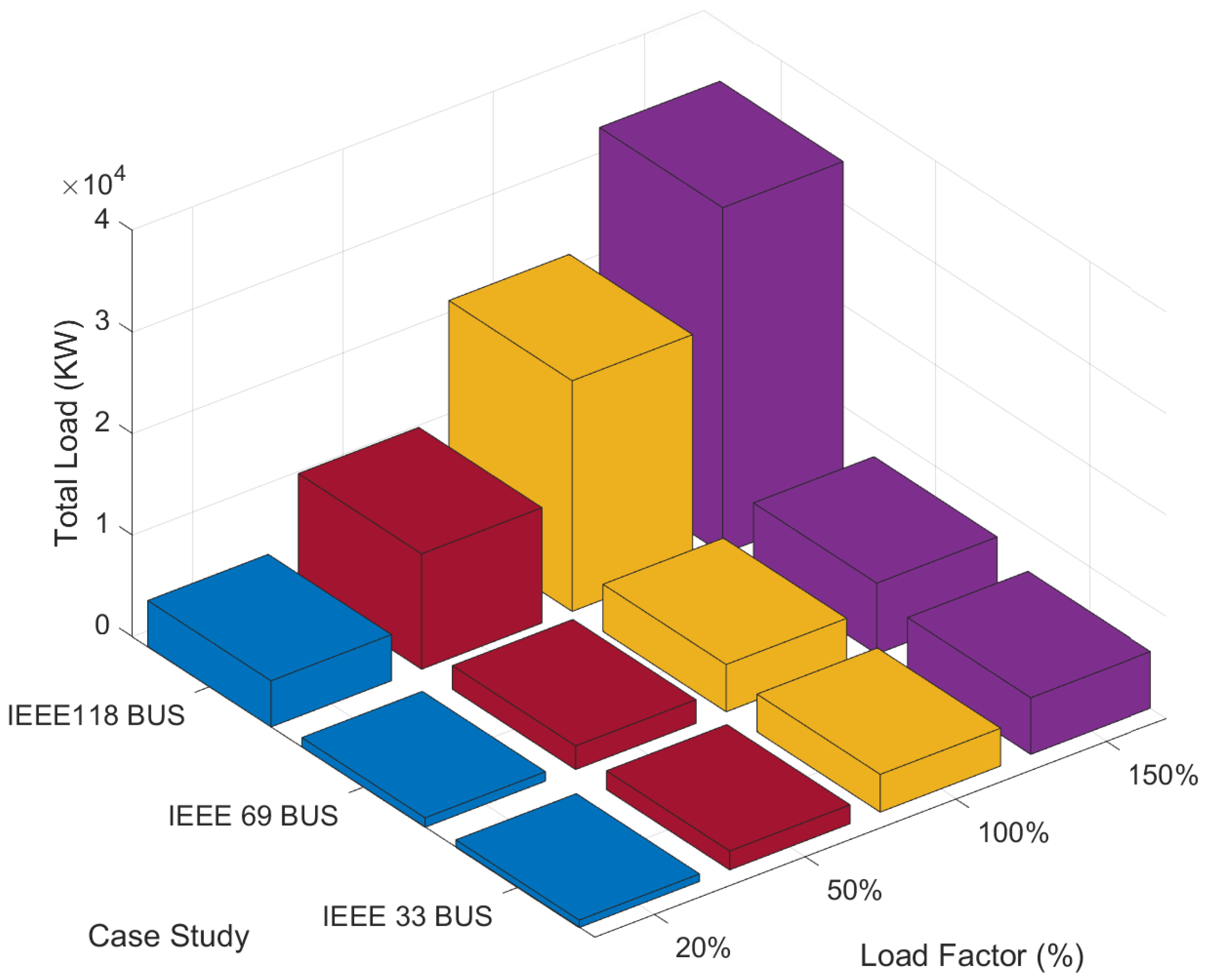


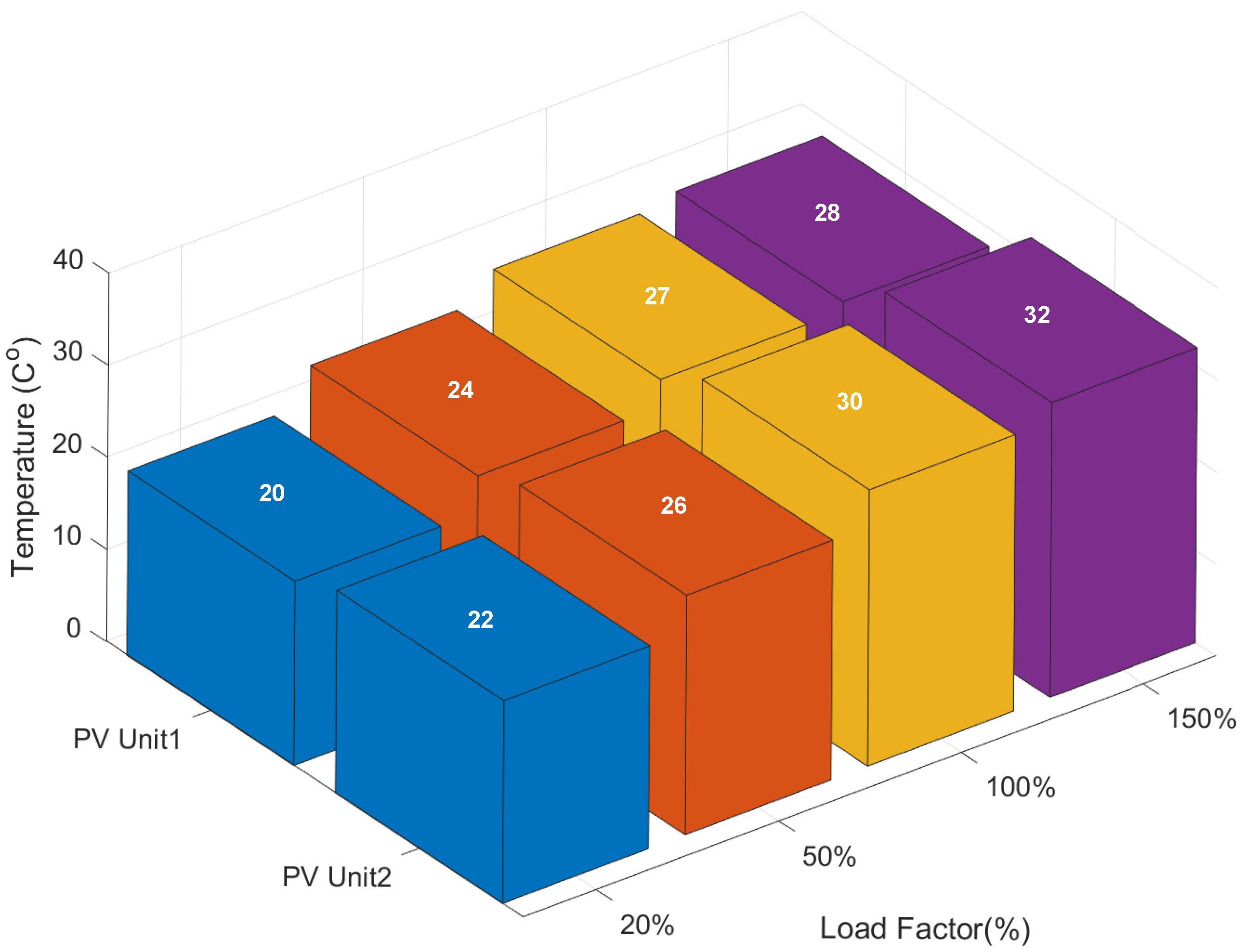





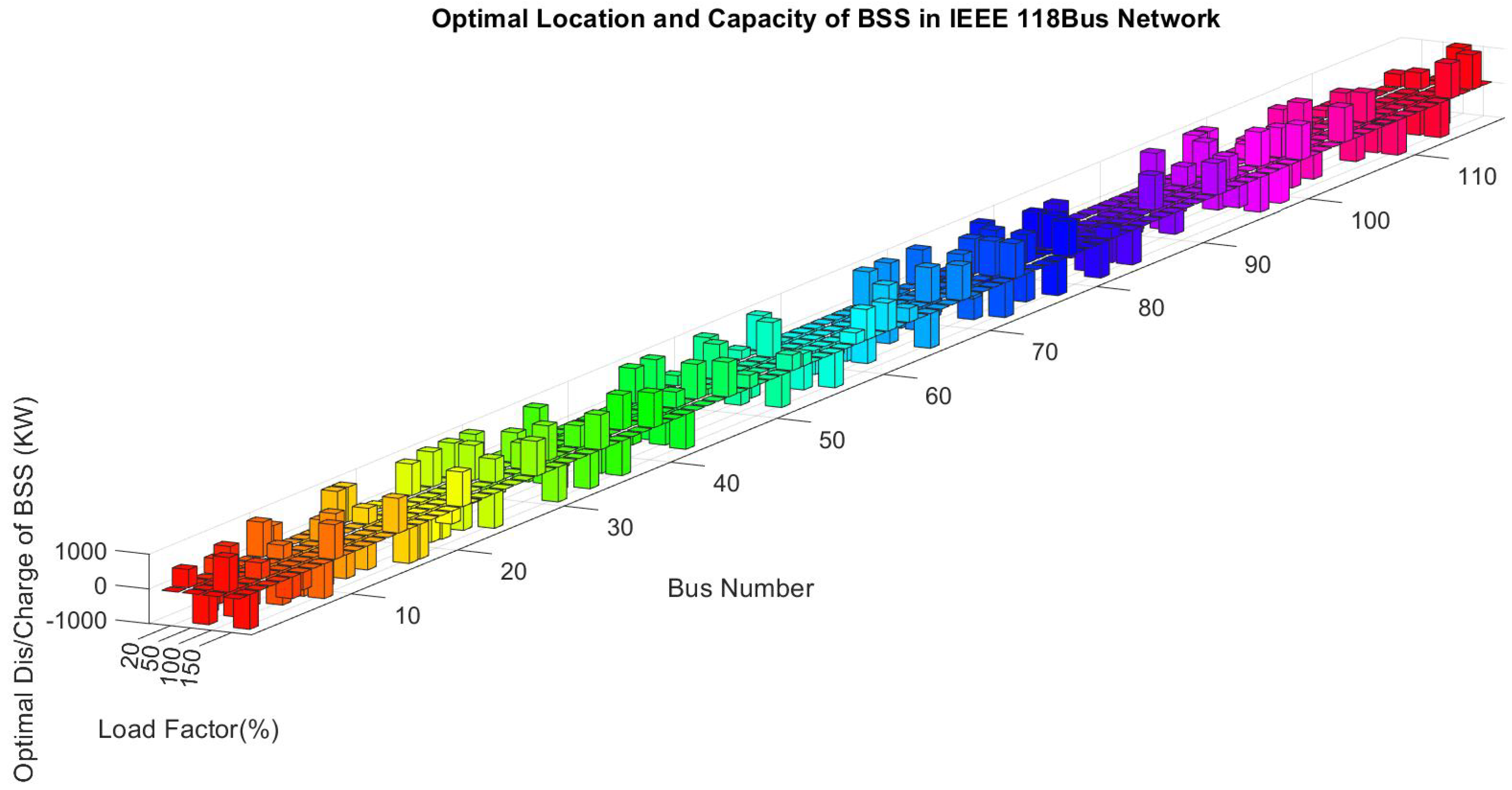


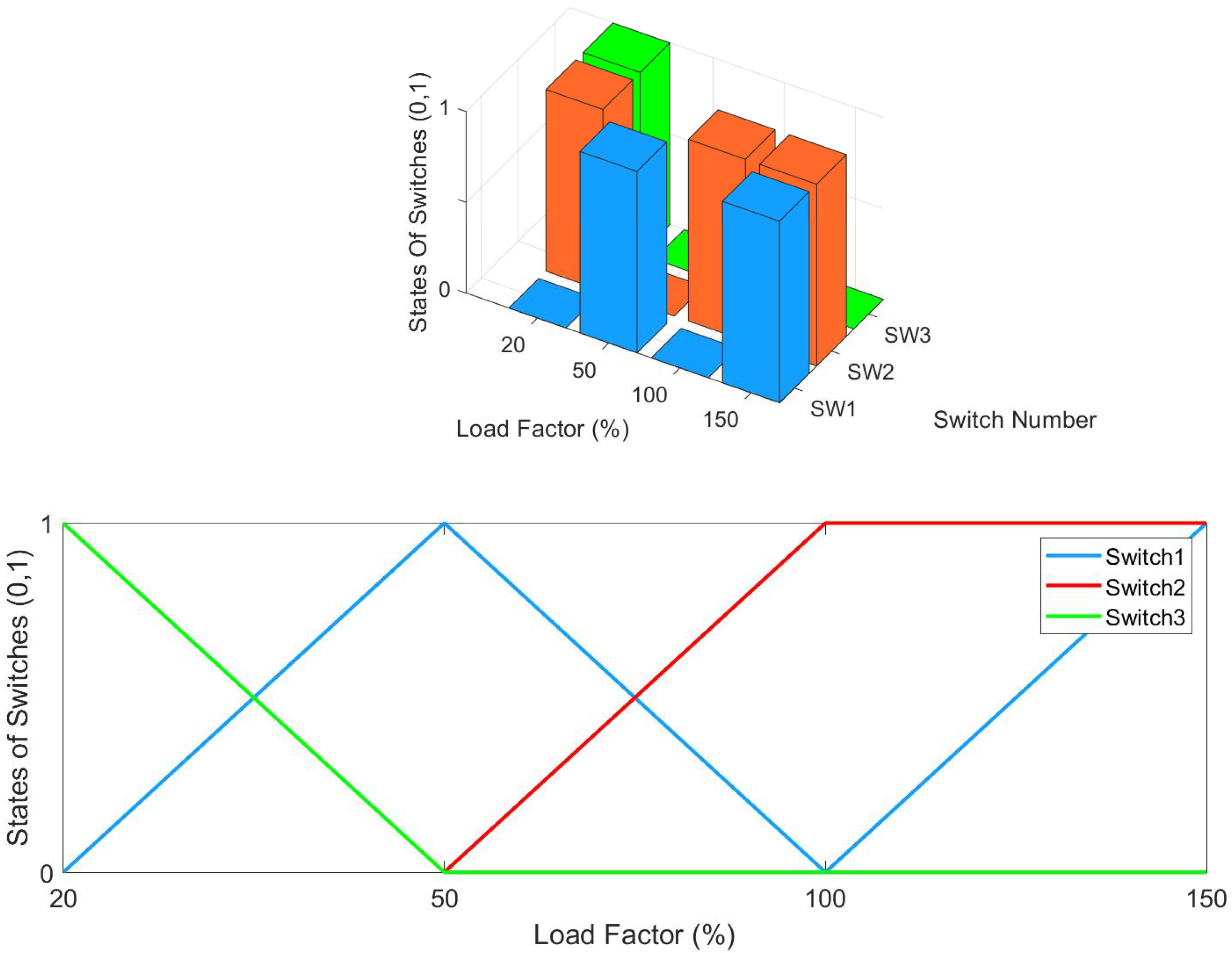


| IEEE 118 Bus | IEEE 69 Bus | IEEE 33 Bus | ||||
|---|---|---|---|---|---|---|
| Switch Number | Coupled Switch Location | Coupled Switch Location | Coupled Switch Location | |||
| Normally open | Normally closed | Normally open | Normally closed | Normally open | Normally closed | |
| 1 | Bus17–Bus27 | Bus11–Bus12 | Bus46–Bus15 | Bus3–Bus36 | Bus25–Bus29 | Bus3–Bus23 |
| 2 | Bus80–Bus99 | Bus68–Bus69 | Bus20–Bus65 | Bus9–Bus53 | Bus5–Bus33 | Bus6–Bus26 |
| 3 | Bus91–Bus115 | Bus104–Bus105 | Bus5–Bus35 | Bus3–Bus28 | Bus12–Bus22 | Bus2–Bus19 |
| Bus Number | Optimal State of Dis/Charging (kWh) of BSSs at Different Percentages of Nominal Load | Bus Number | Optimal State of Dis/Charging (kWh) of BSSs at Different Percentages of Nominal Load | ||||||
|---|---|---|---|---|---|---|---|---|---|
| 20% | 50% | 100% | 150% | 20% | 50% | 100% | 150% | ||
| 1 | 0 | 0 | 0 | 0 | 60 | −1000 | 0 | 0 | 874.548 |
| 2 | 523.571 | −1000 | 1000 | −1000 | 61 | −519.82 | 0 | 0 | 0 |
| 3 | 0 | −521.45 | −846.81 | 0 | 62 | 0 | −1000 | −1000 | 807.008 |
| 4 | −1000 | 1000 | 0 | 0 | 63 | 0 | 0 | 0 | 0 |
| 5 | 444.543 | 0 | 467.19 | 0 | 64 | −1000 | 0 | 1000 | 399.456 |
| 6 | 0 | −1000 | 0 | −623.75 | 65 | 0 | 0 | 0 | 0 |
| 7 | −1000 | 0 | −1000 | −501.03 | 66 | 1000 | −1000 | −47.964 | −1000 |
| 8 | 0 | 0 | 0 | 0 | 67 | 0 | 0 | 0 | 0 |
| 9 | 1000 | 400.055 | −1000 | −1000 | 68 | 1000 | 0 | 1000 | 0 |
| 10 | 775.125 | −1000 | 0 | 1000 | 69 | −1000 | −1000 | 0 | 1000 |
| 11 | −1000 | 0 | −1000 | 0 | 70 | 0 | −770.4 | 0 | −86.382 |
| 12 | 0 | 0 | 1000 | 0 | 71 | 1000 | 0 | 1000 | 0 |
| 13 | 0 | 612.979 | −1000 | 0 | 72 | −1000 | −34.278 | −1000 | 0 |
| 14 | −1000 | 0 | 0 | 0 | 73 | −567.78 | 0 | 0 | −1000 |
| 15 | 0 | 0 | −1000 | 0 | 74 | 0 | 1000 | 1000 | 1000 |
| 16 | 1000 | 0 | 0 | 1000 | 75 | −1000 | 0 | −232.3 | −803.82 |
| 17 | 1000 | 454.839 | −265.73 | −1000 | 76 | 0 | 1000 | 0 | 0 |
| 18 | 0 | −314.93 | 0 | −1000 | 77 | 1000 | −1000 | 818.687 | 0 |
| 19 | 0 | 0 | −403.79 | 0 | 78 | −1000 | −1000 | 0 | −1000 |
| 20 | 81.6294 | 0 | 0 | 0 | 79 | 0 | 0 | −9.3727 | 1000 |
| 21 | 0 | −970.19 | −964.72 | −372.11 | 80 | 0 | 1000 | 1000 | 0 |
| 22 | 0 | 0 | −1000 | 1000 | 81 | 0 | 0 | 0 | 0 |
| 23 | 905.58 | −1000 | 0 | −23.363 | 82 | −406.23 | 1000 | 0 | −1000 |
| 24 | 0 | 0 | −1000 | 0 | 83 | 0 | 0 | −1000 | 301.726 |
| 25 | 1000 | −768.75 | 0 | −1000 | 84 | 0 | 0 | 0 | 0 |
| 26 | 0 | 0 | 0 | 0 | 85 | −1000 | −1000 | −1000 | −1000 |
| 27 | 1000 | 1000 | 676.006 | 0 | 86 | 2.12226 | 0 | 0 | 0 |
| 28 | 0 | 0 | 0 | 0 | 87 | 0 | −1000 | 0 | 0 |
| 29 | 1000 | 0 | 0 | 1000 | 88 | 0 | 0 | 0 | 0 |
| 30 | 0 | 0 | 740.004 | 0 | 89 | −1000 | −778.33 | 1000 | −625.07 |
| 31 | −1000 | 854.918 | 0 | −1000 | 90 | 0 | 0 | 0 | 0 |
| 32 | 0 | 0 | 1000 | 0 | 91 | −1000 | 0 | 0 | 0 |
| 33 | 0 | 0 | −1000 | 0 | 92 | 0 | −1000 | 0 | 0 |
| 34 | −1000 | −1000 | 0 | −1000 | 93 | 1000 | 0 | −196.43 | 910.988 |
| 35 | 1000 | 0 | 620.332 | 1000 | 94 | 0 | 549.319 | 0 | 0 |
| 36 | −1000 | 0 | 149.303 | 0 | 95 | −1000 | −478.27 | −752.23 | −620.77 |
| 37 | −1000 | 0 | −1000 | −1000 | 96 | 0 | 1000 | 656.258 | 0 |
| 38 | 0 | −1000 | 0 | −237.66 | 97 | 1000 | 0 | −96.738 | −1000 |
| 39 | 0 | −519.7 | 1000 | 0 | 98 | 1000 | −1000 | 0 | 0 |
| 40 | −1000 | 0 | 0 | 1000 | 99 | −993.03 | 0 | 984.607 | −1000 |
| 41 | 0 | 0 | 0 | 0 | 100 | 0 | 419.9 | 0 | 0 |
| 42 | 0 | 0 | 0 | 0 | 101 | 0 | 0 | 850.257 | 1000 |
| 43 | 0 | 0 | −945.09 | −1000 | 102 | 237.936 | −1000 | −1000 | 0 |
| 44 | 1000 | −1000 | 452.465 | 0 | 103 | 0 | 0 | 0 | 0 |
| 45 | −673.14 | 0 | 0 | 0 | 104 | 0 | 0 | −1000 | 0 |
| 46 | 1000 | −1000 | 1000 | 0 | 105 | 741.08 | 1000 | 0 | 1000 |
| 47 | 0 | 0 | 168.756 | 1000 | 106 | 405.013 | 0 | 0 | 0 |
| 48 | 284.628 | 0 | 0 | 0 | 107 | 0 | 0 | 0 | 0 |
| 49 | 0 | 0 | −206.96 | 370.976 | 108 | −827.6 | 0 | −1000 | 0 |
| 50 | 0 | 1000 | −96.276 | 0 | 109 | 207.884 | 777.042 | 851.119 | 33.8206 |
| 51 | 1000 | 0 | 0 | 0 | 110 | 210.632 | 0 | −1000 | −1000 |
| 52 | 0 | −1000 | 0 | −933.37 | 111 | 0 | −450.68 | 0 | 0 |
| 53 | −1000 | −922.78 | 0 | 446.985 | 112 | 0 | 0 | 0 | 0 |
| 54 | 257.077 | 0 | 0 | 353.034 | 113 | 134.103 | −1000 | 0 | 0 |
| 55 | 0 | 1000 | 0 | 0 | 114 | 0 | 0 | −1000 | −1000 |
| 56 | 1000 | 0 | −1000 | 0 | 115 | 0 | −234.4 | 0 | 1000 |
| 57 | −521.32 | −1000 | 0 | −1000 | 116 | 362.797 | 477.75 | −1000 | 0 |
| 58 | −1000 | 0 | 0 | 0 | 117 | 0 | 0 | 0 | 1000 |
| 59 | 0 | −1000 | −416.79 | 326.779 | 118 | 0 | −14.107 | 1000 | 0 |
| Bus Number | Optimal State of Dis/Charging (kWh) of BSSs at Different Percentages of Nominal Load | Bus Number | Optimal State of Dis/Charging (kWh) of BSSs at Different Percentages of Nominal Load | ||||||
|---|---|---|---|---|---|---|---|---|---|
| 20% | 50% | 100% | 150% | 20% | 50% | 100% | 150% | ||
| 1 | 0 | 1000 | −1000 | 1000 | 35 | 1000 | 1000 | −1000 | 0 |
| 2 | 1000 | 0 | −385.62 | 0 | 36 | 0 | 0 | 480.231 | −614.18 |
| 3 | 0 | −1000 | 0 | −1000 | 37 | −1000 | −1000 | 0 | −1000 |
| 4 | 0 | 0 | 0 | 0 | 38 | 0 | 0 | 701.071 | 0 |
| 5 | 1000 | 723.346 | 1000 | 1000 | 39 | 0 | 634.73 | 0 | 258.296 |
| 6 | 0 | 0 | −1000 | 0 | 40 | −1000 | −1000 | 1000 | 0 |
| 7 | −1000 | 0 | 0 | −1000 | 41 | −1000 | 0 | 0 | 0 |
| 8 | 0 | 1000 | 595.473 | 0 | 42 | 1000 | 1000 | −1000 | −531.26 |
| 9 | 0 | 0 | 0 | 0 | 43 | 0 | 876.503 | 0 | 0 |
| 10 | 621.568 | 196.493 | 0 | 319.34 | 44 | 0 | 0 | 0 | −403.21 |
| 11 | 842.22 | 0 | 1000 | 0 | 45 | −1000 | −1000 | 1000 | 0 |
| 12 | 0 | −1000 | −1000 | −1000 | 46 | 0 | 1000 | 0 | −307.2 |
| 13 | 0 | 773.802 | 0 | 0 | 47 | 281.831 | 0 | 174.788 | −508.75 |
| 14 | 0 | 0 | −310.99 | 0 | 48 | 0 | 0 | 1000 | 0 |
| 15 | 0 | −1000 | 0 | −879.39 | 49 | 39.5753 | −1000 | 0 | −469.19 |
| 16 | −1000 | 0 | −1000 | 0 | 50 | 0 | 0 | −1000 | 0 |
| 17 | 194.665 | 0 | 1000 | −625.27 | 51 | 1000 | −1000 | 0 | 743.649 |
| 18 | 1000 | −1000 | 0 | 0 | 52 | 0 | 1000 | −1000 | −489.12 |
| 19 | 0 | 1000 | 1000 | 727.966 | 53 | −1000 | −111.68 | 0 | 0 |
| 20 | 0 | −991.96 | 0 | 0 | 54 | 0 | 0 | −824.4 | 682.179 |
| 21 | −1000 | 1000 | −1000 | 995.552 | 55 | −1000 | −1000 | 0 | 0 |
| 22 | 0 | 1000 | −221.91 | −1000 | 56 | 0 | 1000 | −486.82 | −57.385 |
| 23 | 1000 | −1000 | 0 | −1000 | 57 | 0 | 0 | 0 | −640.08 |
| 24 | 0 | 0 | 456.635 | 76.5487 | 58 | 0 | 0 | 0 | −1000 |
| 25 | 407.979 | −1000 | −697.48 | −1000 | 59 | −1000 | −1000 | −1000 | 0 |
| 26 | 0 | −369.67 | −1000 | 1000 | 60 | 0 | 1000 | 0 | −236.62 |
| 27 | −874.55 | −1000 | 0 | 0 | 61 | −1000 | 0 | 0 | 0 |
| 28 | 0 | −1000 | 1000 | 1000 | 62 | 0 | 0 | −968.4 | −65.005 |
| 29 | 0 | 0 | −391.5 | 0 | 63 | 943.29 | 0 | 1000 | 1000 |
| 30 | 0 | 0 | 0 | −1000 | 64 | 0 | −246.06 | 0 | 0 |
| 31 | 0 | 0 | 0 | 0 | 65 | 0 | −272.54 | 0 | −1000 |
| 32 | −536.92 | 878.989 | 0 | 0 | 66 | −209.87 | 0 | 501.54 | 0 |
| 33 | 0 | 0 | −212.52 | −1000 | 67 | 1000 | 0 | −611.79 | −1000 |
| 34 | 0 | 0 | 0 | 897.894 | 68 | 0 | −1000 | 0 | 0 |
| 69 | 1000 | 0 | −1000 | 0 | |||||
| Bus Number | Optimal State of Dis/Charging (kWh) of BSSs at Different Percentages of Nominal Load | Bus Number | Optimal State of Dis/Charging (kWh) of BSSs at Different Percentages of Nominal Load | ||||||
|---|---|---|---|---|---|---|---|---|---|
| 20% | 50% | 100% | 150% | 20% | 50% | 100% | 150% | ||
| 1 | 0 | 250 | 0 | 0 | 17 | 250 | 0 | 0 | 250 |
| 2 | 0 | 0 | 0 | 0 | 18 | 0 | −250 | 250 | 250 |
| 3 | −250 | −250 | 250 | −250 | 19 | 0 | 250 | 250 | 0 |
| 4 | −250 | 0 | 0 | 140.857 | 20 | 250 | 250 | 0 | 250 |
| 5 | 0 | 0 | −250 | 0 | 21 | 0 | 0 | −161.55 | 0 |
| 6 | −250 | 250 | 250 | −250 | 22 | 250 | 250 | 0 | 0 |
| 7 | 0 | −250 | 0 | 0 | 23 | −250 | 250 | −250 | 250 |
| 8 | −250 | 0 | −250 | 64.5045 | 24 | 0 | 0 | 0 | 0 |
| 9 | 250 | 0 | −250 | −250 | 25 | 0 | 0 | 0 | 0 |
| 10 | 0 | 0 | 0 | 0 | 26 | 0 | −250 | 0 | −250 |
| 11 | −250 | −250 | −250 | 0 | 27 | −96.052 | 0 | −250 | −250 |
| 12 | 0 | 0 | 0 | −250 | 28 | 0 | −76.418 | 0 | 0 |
| 13 | 0 | −250 | −250 | 0 | 29 | −250 | 250 | −250 | 250 |
| 14 | 0 | 0 | 250 | 0 | 30 | 250 | 0 | 250 | 0 |
| 15 | −250 | −250 | −250 | 120.263 | 31 | 250 | 0 | −250 | −250 |
| 16 | 0 | 250 | 0 | 0 | 32 | −250 | 0 | 0 | 0 |
| 33 | 0 | 0 | 250 | −250 | |||||
| Objectives | Operating Cost ($) | Losses (kW) | Voltage Deviation (pu) | (EENS) (kWh) | VSI (pu) | Sum of Short-Circuit-Level Changes (pu) | |
|---|---|---|---|---|---|---|---|
| Method | |||||||
| Proposed method | 12,687.72 | 1.33 | 1.36 | 62.62 | 9.982 | 1.93 | |
 |  |  |  |  |  | ||
| [2,3] | 18,452.63 | 6.62 | 6.791 | 114.21 | 5.32 | 4.25 | |
 |  |  |  |  |  | ||
| [7,10] | 24,384.21 | 8.274 | 5.217 | 87.64 | 4.28 | 6.54 | |
 |  |  |  |  |  | ||
| [14,19] | 21,628.64 | 11.427 | 1.87 | 314.21 | 7.81 | 12.37 | |
 |  |  |  |  |  | ||
| Indexes | Operating Cost ($) | Losses (kW) | Voltage Deviation (pu) | (EENS) (kWh) | VSI (pu) | Sum of Short-Circuit-Level Changes (pu) | |
|---|---|---|---|---|---|---|---|
| Method | |||||||
| Proposed method | 1153.01 | 15.09 | 0.81 | 31.19 | 5.00 | 0.751 | |
 |  |  |  |  |  | ||
| [2,3] | 1453.21 | 21.12 | 2.35 | 68.21 | 4.21 | 8.51 | |
 |  |  |  |  |  | ||
| [7,10] | 1712.31 | 16.32 | 6.31 | 38.54 | 1.24 | 10.24 | |
 |  |  |  |  |  | ||
| [14,19] | 1471.14 | 18.25 | 3.98 | 48.56 | 2.94 | 11.71 | |
 |  |  |  |  |  | ||
| Indexes | Operating Cost ($) | Losses (kW) | Voltage Deviation (pu) | (EENS) (kWh) | VSI (pu) | Sum of Short-Circuit-Level Changes (pu) | |
|---|---|---|---|---|---|---|---|
| Method | |||||||
| Proposed method | 3401.21 | 1.82 | 0.29 | 56.08 | 1.55 | 0.929 | |
 |  |  |  |  |  | ||
| [2,3] | 5061.28 | 3.21 | 2.63 | 63.21 | 1.23 | 1.24 | |
 |  |  |  |  |  | ||
| [7,10] | 4716.25 | 4.612 | 3.83 | 59.32 | 0.68 | 5.28 | |
 |  |  |  |  |  | ||
| [14,19] | 4781.21 | 8.241 | 0.81 | 71.23 | 0.94 | 3.67 | |
 |  |  |  |  |  | ||
Disclaimer/Publisher’s Note: The statements, opinions and data contained in all publications are solely those of the individual author(s) and contributor(s) and not of MDPI and/or the editor(s). MDPI and/or the editor(s) disclaim responsibility for any injury to people or property resulting from any ideas, methods, instructions or products referred to in the content. |
© 2024 by the authors. Licensee MDPI, Basel, Switzerland. This article is an open access article distributed under the terms and conditions of the Creative Commons Attribution (CC BY) license (https://creativecommons.org/licenses/by/4.0/).
Share and Cite
Al-Zaidi, W.K.M.; Inan, A. Optimal Planning of Battery Swapping Stations Incorporating Dynamic Network Reconfiguration Considering Technical Aspects of the Power Grid. Appl. Sci. 2024, 14, 3795. https://doi.org/10.3390/app14093795
Al-Zaidi WKM, Inan A. Optimal Planning of Battery Swapping Stations Incorporating Dynamic Network Reconfiguration Considering Technical Aspects of the Power Grid. Applied Sciences. 2024; 14(9):3795. https://doi.org/10.3390/app14093795
Chicago/Turabian StyleAl-Zaidi, Waleed Khalid Mahmood, and Aslan Inan. 2024. "Optimal Planning of Battery Swapping Stations Incorporating Dynamic Network Reconfiguration Considering Technical Aspects of the Power Grid" Applied Sciences 14, no. 9: 3795. https://doi.org/10.3390/app14093795
APA StyleAl-Zaidi, W. K. M., & Inan, A. (2024). Optimal Planning of Battery Swapping Stations Incorporating Dynamic Network Reconfiguration Considering Technical Aspects of the Power Grid. Applied Sciences, 14(9), 3795. https://doi.org/10.3390/app14093795







